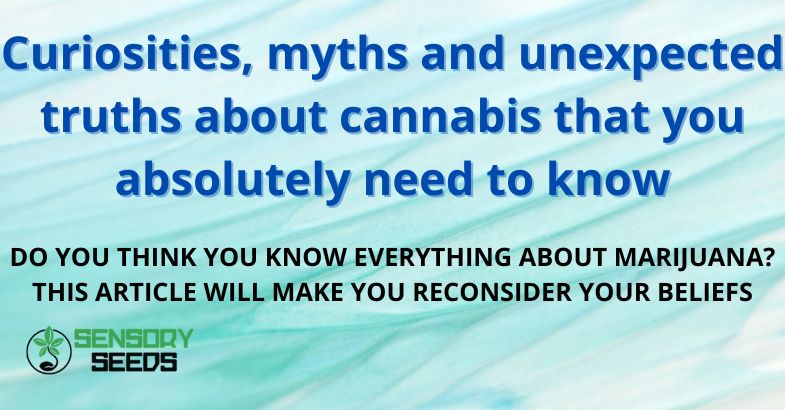Published on: 05/02/2024
DO YOU THINK YOU KNOW EVERYTHING ABOUT MARIJUANA? THIS ARTICLE WILL MAKE YOU RECONSIDER YOUR BELIEFS
On the topic of cannabis and cannabis seeds, stories and perceptions are intertwined in a mosaic of beliefs and experiences. There are those who view it with suspicion, others who celebrate it as a natural blessing; some fear it, while for others it has become a central element of their lives. There are those who use it occasionally, those who are fascinated by it, those who choose it for its culinary qualities and those who prefer to stay away from it.
Your perspective on cannabis may be rooted in personal experiences or deep beliefs, but this article, in which we have compiled some of the strangest and most interesting curiosities and myths about cannabis, could reveal details and unpublished facts that could confirm what you think, but it will also, perhaps, lead you to reconsider some of your strongest beliefs.
Read also: Medical cannabis: a possible remedy for migraines?
Use in childbirth in the past
It may seem impossible but, until 1942, cannabis was used as a remedy for childbirth pains. This traditional use, surprising today, testifies to the ancient awareness of the plant’s analgesic properties. A practice that, although obsolete, reflects the long history of cannabis in the medicinal field.
Breast milk and endocannabinoids
A lesser known, but no less fascinating, detail is the natural presence of endocannabinoids in breast milk. These compounds, similar to THC (the main active ingredient in marijuana), play a fundamental role in stimulating appetite and satiety in newborns, highlighting a surprising biological connection between the human body and cannabis derived by weed seeds.


Frequency of sexual relations
A study published in Stanford Medicine revealed that regular cannabis users tend to have more sex than non-users. These data, although requiring more research to fully understand their implications, suggest an interesting link between cannabis use and sex life.
Pulp fiction and temporal symbolism
An emblematic example of the impact of cannabis culture on cinema is Quentin Tarantino’s cult film “Pulp Fiction”, where almost all the clocks read “4:20”. This detail is a clear reference to cannabis culture, since “4:20” is a code used in popular culture to indicate marijuana consumption. This subtle but telling reference highlights the influence of cannabis on popular culture and language.
George Washington and marijuana cultivation
The history of cannabis in the United States immediately recalls the 1930s and the rise of prohibition. However, George Washington, the first president of the United States, is known for having grown marijuana. Some historians suggest that he may also have used it for medicinal purposes, especially to relieve pain caused by his dentures.
The United States and the obligation to grow hemp
Curiously, and in a thematic addition to the previous anecdote, the history of cannabis in the US also includes periods in which its cultivation was mandatory. In the early years of American colonization, for example, hemp was so essential to the production of rope and fabric that colonists had a duty to grow it, with severe penalties for those who did not comply with these guidelines.
Cannabis and the Moai of Easter Island
A fascinating historical curiosity links cannabis to the mysterious Moai of Easter Island. According to a California State University study published in 2012, hemp may have played an unexpected role in transporting these colossal statues, as it was used to make ropes and other tools necessary for such an undertaking. While this theory is not universally accepted, it offers an intriguing example of how cannabis may be intertwined with the mysteries of human history.
The impossibility of an overdose
One of the most widespread myths refers to the possibility of suffering from a cannabis overdose. The reality is that a fatal cannabis overdose is extremely improbable. Research indicates that it would be necessary to consume an exorbitant amount, far above the human consumption capacity, to reach a lethal level of THC. This widespread and persistent myth highlights the importance of distinguishing between scientific facts and popular beliefs.
Urban legends and pop culture
Cannabis has also inspired several urban legends in pop culture. For example, the widespread belief that consuming THC-based foods can triple the effect compared to smoking it, as an example of how the plant is the subject of interpretations and myths. These types of stories, often without a scientific basis, contribute to the cultural narrative around cannabis derived by autoflowering seeds.
Effect on hunger and other interactions of cannabis with food
A well-known aspect of cannabis use is its appetite-stimulating effect, often referred to as “munchies.” This phenomenon is mainly attributed to THC (tetrahydrocannabinol), the main psychoactive compound in cannabis. Studies have shown that THC interacts with specific receptors in the brain that can intensify feelings of hunger. This characteristic has important implications, especially in the context of appetite management in patients undergoing treatments such as chemotherapy.
Interestingly, some foods can influence the effects of cannabis. Studies have indicated that foods containing certain fatty acids, such as walnuts, can enhance the effects of cannabinoids. Likewise, vegetables such as broccoli, rich in terpenes, can interact with cannabis, enhancing some of its positive effects, such as combating depression.
Cannabis variety with an unusual aroma
One of the most interesting aspects of cannabis is the diversity of its aromas. Marijuana seeds have been selected from some varieties, for example, known for their smell reminiscent of cheese (yes, that’s right). This particular aroma is due to the presence of certain acids in the terpenes, the compounds responsible for the smell and some medicinal properties of the plant. Among these acids we find caproic acid and isovaleric acid, which contribute to giving cannabis these unusual aromas.
Environmental sustainability of hemp
From an environmental point of view, cannabis (particularly hemp, a non-psychoactive variety of cannabis) is a particularly sustainable crop. For example, one acre of hemp can produce the same amount of paper as four acres of forest, but with a much faster growth cycle. In addition, it requires less water and pesticides than other crops, making it an ecological and sustainable option for producing different materials.


Effects of THC on pets
One aspect of great interest is the effect of THC (the active ingredient in cannabis) on pets, especially dogs. Accidental exposure to THC can cause significantly more intense effects in these animals than in humans, causing symptoms such as dilated pupils, hyperarousal, and uncontrolled muscle movements. These episodes, although rare, are worrying and require immediate veterinary treatment, usually with supportive therapies and, in more severe cases, gastric lavage.
Cannabis as a food for pigs
A curious case in reference to cannabis in the animal world is represented by the consumption of marijuana in Bhutan, where the plant grows abundantly and uncontrolled. In fact, traditionally the neighbors did not use it for recreational purposes, but as food for pigs. This alternative use of cannabis reveals how the plant can have different and unexpected applications in livestock and agriculture.
Read also: Everything you need to know about cannabis bonsai: characteristics and growth techniques
In conclusion
This article highlights the complexity and richness of the world of cannabis, a plant that has played an important role in human history, culture and medicine. From its ancient use to relieve labor pains, to the surprising presence of endocannabinoids in breast milk, cannabis turns out to be a substance with multiple faces and implications.
Its impact on popular culture, as evidenced in films such as “Pulp Fiction,” highlights its role in influencing various aspects of everyday life and culture. At the same time, the history of figures such as George Washington and the mandatory cultivation of hemp in the United States in the past reveal the historical and economic importance of the plant.
Interestingly, not even the animal world is exempt from the influence of cannabis, as shown by studies on the effects of THC on domestic animals and the use of the plant as pig feed in Bhutan.
Did you already know all this information that we tell you or is it completely new to you? Whatever the answer, you should know that here at Sensoryseeds you can find many other items designed specifically for marijuana enthusiasts. Take a look at our blog and, if you are a collector, be sure to visit the store: you will find many varieties of cannabis seeds selected for their high quality.
Takeaways
Cannabis culture has had a significant impact on popular culture, as evidenced by Quentin Tarantino’s film “Pulp Fiction,” where the time “4:20” is a clear reference to marijuana use.
The first president of the United States, George Washington, is known to have grown marijuana, suggesting an interesting historical aspect of his presence in the country. The past mandatory cultivation of hemp in the United States further highlights its historical and economic importance.
Contrary to common myth, it is extremely unlikely to die from a cannabis overdose, which requires massive quantities far beyond human consumption capacity.
The diversity of cannabis aromas is fascinating, and some strains emit unusual smells, such as cheese, due to specific terpene compounds.
Growing hemp, especially the non-psychoactive variety, is ecologically sustainable, requires fewer resources than other crops, and has multiple uses.
Questions and answers
Has cannabis always been prohibited in the United States?
No, cannabis was not always prohibited in the United States. There were periods (for example the first years of American colonization) in which its cultivation was mandatory and others in which it was regulated or prohibited.
Why does the clock read 4:20 in Pulp Fiction?
In Pulp Fiction, the clock reads 4:20 as a reference to cannabis culture, where ‘4:20’ is a popular code for marijuana use.
Is it possible to suffer a cannabis overdose?
It is extremely unlikely to suffer a cannabis overdose. It would be necessary to consume exorbitant amounts, far above human capacity, to reach a lethal level of THC.









